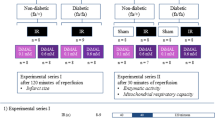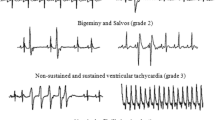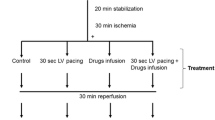Summary
This study was done to evaluate the response of myopathic hearts from dystrophic hamsters to 30 minutes of ischemia followed by 30 minutes of reperfusion. Hearts from male and female normal animals recovered 77±6% and 64±5% of their contractile force respectively following reperfusion whereas only 34±8% (male) and 34±7% (female) recovery was seen in myopathic hearts (P<0.01). Substantial sustained contractures were observed ruring reperfusion in hearts from dystrophic animals irrespective of gender whereas none were seen with control hearts. Reperfusion produced a rapid release of CPK that peaked at 5 minutes (approximate coronary effluent concentration of 40 mU/ml) and remained elevated for the reperfusion duration. Peak CPK values for normal hearts were reached at 10 minutes following reperfusion, were significantly lower from the myopathic hearts and returned to near control levels at the end of the 30 minute reperfusion period. Reducing Ca2+ in the perfusion medium by up to 80% or perfusing the hearts with the Ca2+-channel blocker verapamil produced no beneficial effects. Changes in the above parameters produced by ischemia or heart rate alterations throughout the perfusion sequence were not different between normal and myopathic hearts. This study shows a sensitivity of myopathic hearts that is manifested during reperfusion. Possible mechanisms for this reduced tolerance are discussed.
Similar content being viewed by others
References
Fitzpatrick DB, Karmazyn M (1984) Comparative effects of calcium channel blocking agents and varying extracellular calcium concentration on hypoxia/reoxygenation and ischemia/reperfusion-induced cardiac injury. J Pharmacol Exp Ther 228:761–768
Hearse DJ (1977) Reperfusion of the ischemic myocardium. J Mol Cell Cardiol 9:605–616
Hunter EG, Hughes V, White J (1984) Cardiomyophathic hamsters, CHF 146 and CHF 147: preliminary study. Can J Physiol. Pharmacol 62:1423–1428
Jasmin G, Eu HY (1979) Cardiomyopathy of hamster dystrophy. Ann NY Acad Sci 317:46–58
Nayler NG, Ferrari R, Williams A (1980) Protective effect of pretreatment with verapamil, nifedipine and propranolol on mitochondrial function in the ischemic and reperfused myocardium. Am J Cardiol 46:242–248
Sakai K, Gebhard MM, Spieckermann PG, Bretschender H (1975) Enzyme release resulting from total ischemia and reperfusion in the isolated perfused guinea pig heart. J Mol Cell Cardiol 7:827–840
Wrogemann K, Hayward WAK, Blanchaer MC (1979) Biochemical aspects of muscle necrosis in hamster dystrophy. Ann NY Acad Sci 317:30–45
Author information
Authors and Affiliations
Rights and permissions
About this article
Cite this article
Karmazyn, M. Reduced tolerance to reperfusion-associated injury in hearts from myopathic hamsters. Basic Res Cardiol 80, 392–398 (1985). https://doi.org/10.1007/BF01908183
Received:
Issue Date:
DOI: https://doi.org/10.1007/BF01908183




